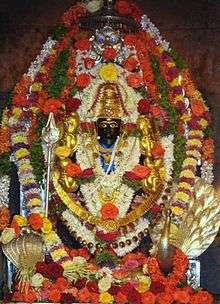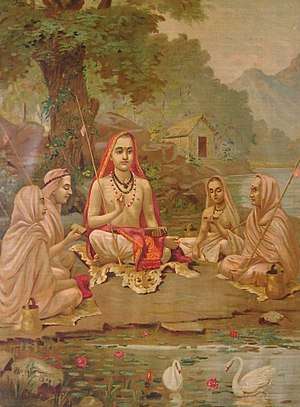Sthanika Brahmins
 Shri Jnanashakti Subrahmanyaswami, Pavanje | |
| Regions with significant populations | |
|---|---|
| Indian states of Karnataka, Maharashtra, Kerala | |
| Languages | |
| Tulu, Kannada and Sanskrit | |
| Religion | |
|
Sthānika Brāhmins belong to Hindu Pancha Dravida Tuluva Smartha Brahmin group.
They are the oldest Tulu Brāhmins[1] primarily from the coastal Karnataka (Kanara) also known as Parasurama Kshetra..They are the main Prathistapanacharyas/Founders of all temples and bhoota sthanas in tulu nadu
They are one of the oldest brahmins of South India and are referred to in many ancient historical epigraphical inscriptions as; Buddhivantha, Sthaneekam, Sthanapanthulu, Sthanadhikari, Sthanatthar, Sthalatthar, Sthanapadiyan, Stahliathiri, Thaniker, Sthanikar, Sthānādhipathi, Sthānādhyaksha, Tuḷu brahmins. Sthānika Brahmins of south canara are referred to as Subrahmanya Sthānika Brāhmins as Lord Subrahmanya is their kuladevata and Kukke subramanya temple was their main center until the 16th century.[2]
Sthānika Brāhmins are followers of Advaita Philosophy and practice the Panchayatana form of worship. They are disciples of the Sri Sringeri Jagadguru Samsthanam from the time of Sri Adi Shankara.[2]
Caste
Etymology
The word Sthānika is a sanskrit word and has meanings such as 'Fixed worshiper', 'Chief priest of a temple',[3] 'chief tantri', 'Tantraagami', 'melu shanthiyavanu','Sarva shastra paramgata', 'Manager or Administrator of temple', 'One who holds managerial position', 'Governor of a place', 'Tax collector', 'People of local place', etc. Sthānika Brahmins acquired their name owing to their managerial positions such as 'Chief priest of a temples' ,"Tantris", Temple administrators, tax collectors etc.[4][5][6][7]
History
Sthānika Brāhmins history in Tulunadu dates back even before 380BC. From Historical records (stone, copper plate inscriptions and literature) ranging over a period of more than twenty centuries till the end of the 18th century, we can deduce and establish the facts, the origin, the history and the importance of the Sthānika brāhmins in the history of Tulunadu. Most of the temple in South canara region was maintained by Sthanika brahmins
Sthānika Brāhmins were highly respected by, for their character, knowledge, proficiency, and efficiency. During the first quarter of the eighteenth century A.D., the Sthanikas in Tulu speaking region of coastal Karnataka lost their reputed position because of the acute Saiva-Vaisnava (Madhva) rivalry,[8] the changed political set up, the British revenue policies and as they joined their hands in freedom fights supporting the local rulers of that time.
In 1836 Dewan Lakshminarayya a Sthanika brahmin started the first Non-cooperation movement in south canara and prepared a plan to revolt against the British rule with the help of the king of Kodagu. Till 1845, the administration & chief priesthood of all temples was with Sthanika Brahmins and had an influence over large section of the people. The Sthanika Brahmins who were at the helm of affairs in anti-British movement, were sacked from their tradltlonal posts and their hereditary trusteeship of the temple was also cancelled. A large number of people from the community also have been hanged to death by British and the community became economically poor.[9][10][11]
Today sthanikas being well educated and economically well positioned joining their hands establishing unity among the different subsects of Dravida Brahmins and continue to be disciples of Sringeri Sharada Peetham.[12]

Language and food
The Sthanika Brahmins' mother tongue is "Tulu", "Sanskrit" and "Kannada". They speak a different dialect of Tulu called Brahmin Tulu, unique to their community. Sthanika brahmins are purely vegetarians.
Deities and festivals
Sthānika brāhmins offer Panchayatana puja worship introduced by Adi Shankara and celebrate all the festivals of South Canara. They are smartha brahmins with predominant Shaiva -Shakta leanings and mainly perform Shivalinga archana and Koorma peetastha poorna meru shree chakra aaradhana. They mainly belong to the "Rigveda- shakala Shakha-Ashwalayana sootra" and rigveda samhita parayana forms the main crux of their daily rituals.Nagaradhane in the form of Nagamandalotsava is followed very religiously.Sthanika brahmins celebrate all major Hindu festivals such as Ugadi,Nagarapanchami, Ganesh Chaturthi, Deepavali, Navaratri, Sankranti, Janmashtami,Shankara jayanthi, maha shivaratri, Visu Parba(Tulu New Year), Ramanavami, Hanuman Jayanthi etc. They also believe in nagaradhane and rituals of Bhuta Kola.
Gotra and pravara
The following gotras and pravaras are found in the community.[13]
| Gotra | Pravara |
|---|---|
| Vishwāmitra | Vaishwāmitra — Devarāta — Oudala |
| Vishwāmitra | Vaishwāmitra — Mādhucchandasa- Dhānanjaya |
| Kāshyapa | Kāshyapa — Avatsāra — Naidhruva |
| Vasista | Vāsista — Indrapramada — Bharadwasu |
| Āngirasa | Āngirasa — Āmbarisha — Youvanāshwa |
| Bharadwaja | Angirasa - Bhāraspatya - Bhāradwaja |
| Bhārgava | Bhargava - Chyavana - Apnavaan |
| Atri | Ātreya - Archanānasa - Shyāvashwa |
Surnames of families
Sthanika brahmin families surnames are as follows;
- Ayya - Similar to Iyer of tamil. It is derived from Arya of Sanskrit
- Oja- An honorofic title given to certain families by kings and emperors along with Tamra patra shasana (certificate). It is given to those families well versed in all four vedas; vedangas;upangas; and upavedas along with tantragama and mantravada. They are teachers and examiner in chief in gurukulas and ghatikasthaana temples e.g-Chera Nattoja-They were the moola prathistapanacharya /tantragami of Puttur Mahalingeshwara, Vittla panchalingeshwara and Polali shree RajarajeshwariTemples. Moroja- They were the high priests of Mayoorvarma king and moola prathistapancharya and tantragami of Kukke Subrahmanyeshwara temple.
- Shrouti- Families who has performed nakshtresti yagyna
- Agnihotri- Families performing agnihotra of three aahitaagnis namely garhapatya,avahaneeya,dakshinayana agnis as daily rituals
- Deekshitha-Families who were consecrated as brahma for Somayaga
- Somayaji- Families who have performed Somayaga
- Tantri- Families well versed in Shaiva,pancharatra and Vaikhanasa agamas and Shakta tantras.
- Samaga- Families of samaveda and sangeeta shastra (music)
- Bhatta- Families which officiates Gruhya sutra rituals.
- Dwivedi,*Trivedi,*chaturvedi -Families proficiency in the number of vedas studied
- Shastri- Families proficient in vedangas like siksha, vyakarana along with pratishakya,nighantu/nirukta,jyothisha,Kalpa,Chandas.
- Sharma - Families proficient in upanga darshana shastras like vaisheshika ,nyaya,Samkhya, yoga, meemamsa ,vedanta.
- Joisha- Families teaching and practicing jyothisha/astrology
- Avadhani- Families teaching siddhanta and samhita part of astrology and preparing panchangam.
- Upadhyaya- Families proficient in kavya, vyakarana and dharma shastra
- Rayaru,Rao-Families appointed by kings to look after the whole affairs of admimistration and state.
- Hebbar- Family of repute in conducting car festivals of temples
- Acharya- Family of teachers of vedas
See also
References
- ↑ Karnataka State Gazetteer Volume 1, 1973, Dakshina Kannada District Chapter 3 - People
- 1 2 STHANIKAS - Their Socio-religious and Economic Role in Karnataka (A. D. 1215-1800) - Dr. K. G. Vasanthamadhava
- ↑ Economic Conditions in Karnataka, A.D. 973-A.D. 1336, p216
- ↑ Tulu Nadu - Samajika Chariteyalli ondu samshodhanatmaka Vivechane
- ↑ Sthanika Brahmanaru by I. K. Shrinivasa Rao, School Book company - 1957
- ↑ Tulunadina Itihasadalli Sthanika Brahmanaru
- ↑ History of Sthanika Brahmins by Sri C. S. Rao
- ↑ Being Brahmin, Being Modern: Exploring the Lives of Caste Today, Ramesh Bairy TS, 2010, p.163 ISBN 978-0415585767
- ↑ History of Sthanika Brahmanas
- ↑ The Land with A Rich Past, R P Sambasadaslva Reddy, dated 02 –July-1996, Deccan Herald News paper
- ↑ South Kanara, By N. Shyam Bhat, Chapter 7: Rebellian of Kalyanaswami
- ↑ Tattvāloka, Volume 25, Publisher: Sri Abhinava Vidyatheertha Educational Trust, 2002, p 134
- ↑ Ahnika Darpanam — Dr. N.V Upadhyaya
External links
- Akhila Bharatha Sthanika Brahmana Sabha (ABSBS)
- The Sthanikas And Their Historical Importance
- Sthanika Brahmanaru - I. K. Shrinivasa Rao
- Dakshinamnaya Sri Sharada Peetham, Sringeri
- Adi Sankaracharya and Advaita Vedanta Library
- "Tatvāloka" an international English monthly magazine of Hindu religion
- https://archive.org/details/TheLandWithRichPast
- https://archive.org/details/KukkeSriSubrahmanyaKshetra